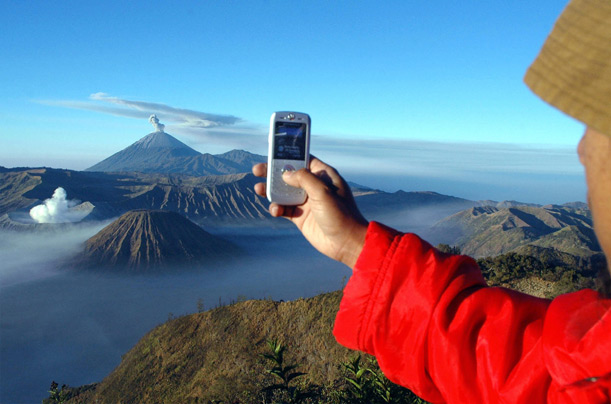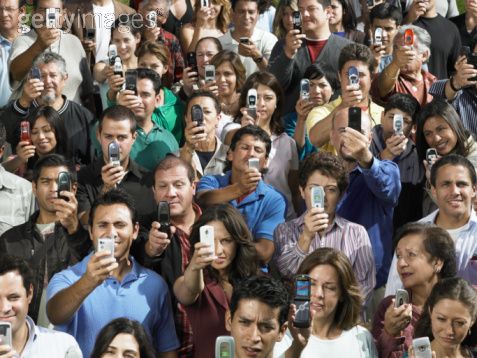
“I Am The Camera” – Christopher Isherwood
The cellphone is now the most ubiquitous computer on earth. Today, those consumers in India are skipping the PC and jumping directly to the “converged device”. In a shocking brush fire of adoptability, the cellphone has replaced the laptop and the desktop computers as the computer of preference globally. Most interestingly, the smartphone which includes all the goodies in media — stills, videos,music, email — has set its flag on the world stage. It is just a matter of time before the smart phone becomes it’s star. Blink! In a period of just 10 years, the mobile phone was revolutionized the lives we lead — how we talk, work, love, and find each other.
It’s kinduh funny when you look below at that sexy, cool cell phone that French athlete, Frank Piccard, used just 21 years ago to let his Mom know about the Gold he won at the Winter Olympics in Calgary .
Of course, our phones have become a lot smaller since Piccard’s race in the snow and their reach a lot bigger. In the last 3 years the market share of smart phones has doubled to a whopping 1.03 billion and its projected growth is exponential, according to the latest report from Strategy Analytics. By the way, over 3.8 billion in the world use a cellphone, over 60% of world’s current population. “For children growing up today the issue is not whether they will get a mobile phone, it’s a question of when,” said Mark Newman,Research Chief at Informa.
Now, the smartphone — it’s just a thing. It’s agnostic — just like carriers are from at&t to Verizen to Sprint. The smart phones don’t create content — you do. The carriers don’t make content — you do. Every time you push a text, a twitter, a picture, a video — you are distributing a reflection of yourself to the world, and a reflection of how you perceive the world. Depending on how closed or open your distribution loop is, you potentially are reaching over 3 billion people. That’s a lot more people that ever saw Walter Cronkite or Michael Jackson! It’s an overwhelming responsibility. Now that I think about it, I want to to go back to bed and hide my head over the covers. No wonder I was so anxious about what my avatar should look like for twitter!
I spent most of my adult life in the Hollywood Studio system agonizing with film-makers over lines of dialogue, movie star entrances, when the music swells, and what a satisfying last reel would look like. It often took us years to push “send” between greenlighting a production and distributing it — a distribution date would be set, reels of film would be put on trucks, and placed on platters, and screened in multiplexes for the world. I know it sounds arcane, it sounds arcane to me and I lived it — but that pretty much is how it still is in traditional theatrical distribution. But what we believed we were doing was creating works of art. I grew up in an industry that packaged dreams; I grew up in a dream — glued to movies like The Brain Eaters and Spartacus. My silver screen progenitor was Cary Grant, “the Man from Dream City”, as Pauline Kael referred to him. Sometimes in that studio system, we succeeded making enduring art with movies like Terms of Endearment and Godfather; sometimes we failed with efforts like Explorers.
Creativity is such a liberating act. It improves the quality of our lives whether we are creating or watching creation. It is at the highest and most refined level of human activity as indicated by Maslow’s pyramid of hierarchal needs. Creativity is what makes us uniquely human. But now, you don’t need trucks and reels and infrastructure and uber capital to reach the world — you have it at your fingertip. In so many ways, your smart phone becomes your paintbrush and you are the master of how you want to color the world, and how you present yourself to your vast global audience.
According to the latest PEW Internet and American Life Report, 64% of online teens between the age of 12 to 17 consider themselves content creators. It was not so long ago that Samuel Morse from Charleston Masachusetts launched the information age with the single wire telegraph, and Morse Code.
Heartbroken at not knowing about his young wife’s sudden death 2000 miles away ( because messages could only be sent by way of horse), Morse decided to change the way information was delivered. He dedicated his renaissance-level gifts to creating a rapid long distance communication system. In 1844, Morse Code and the American telegraph were born when Morse sent out the now famous words “What God Hath Wrought,” through virtual space. Those words from scripture moved with immediacy from Baltimore to New York City. It is profound to note that the virtual network we all enjoy today stemmed from a Massachusetts man moved by heartbreak and restoration. It was his human need to get the news of joy and tragedy more immediately to those he loved.
Every text, picture, video, music you send remains hovering in virtual space. Your artistic work could potentially touch lives for days, years, and generations. That doesn’t mean you need to be wracked by responsibility, a default system for me. This artistic opportunity could empower you to connect deeply with someone else. Think of your smartphone as a paintbrush that can color the world. As you text and twitter and shoot stills and videos from the smartphone, remember that your work is touching the global village. This artistic work can refract your innermost sense of wrong-doing, your own contradictions, your faith, your accomplishments, your troubles, your joys. It is hard to believe that the brush that moved Carravagio, DaVinci, Hopper and Picasso is now in your hand. The Polaroid and it’s film may now be gone – but hopefully the poloroid work of Wharhol and Hockney will live on. Art defines culture. It transcends sex, generation and race. Samuel Morse was not wrong when he tapped “What God Hath Wrought” a 150 years ago in Batimore. The power of the electronic age is astounding. the medium is the message. When you push send, you are truly pumping out brush strokes that are coloring the world. It is now up to you to decide what that world will look like.









